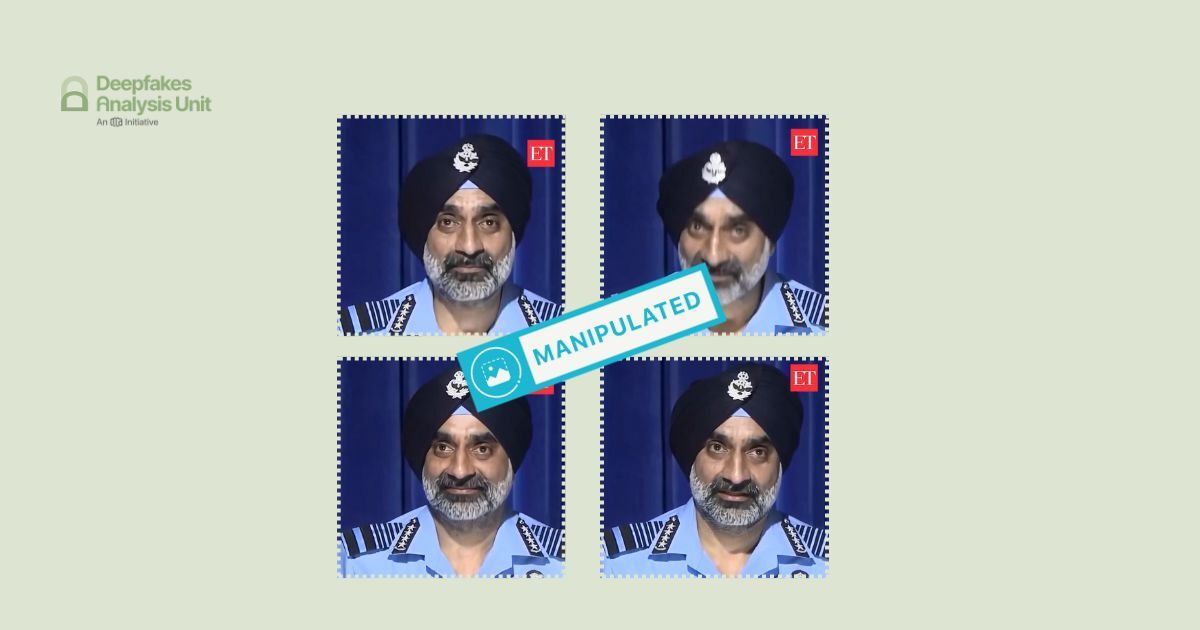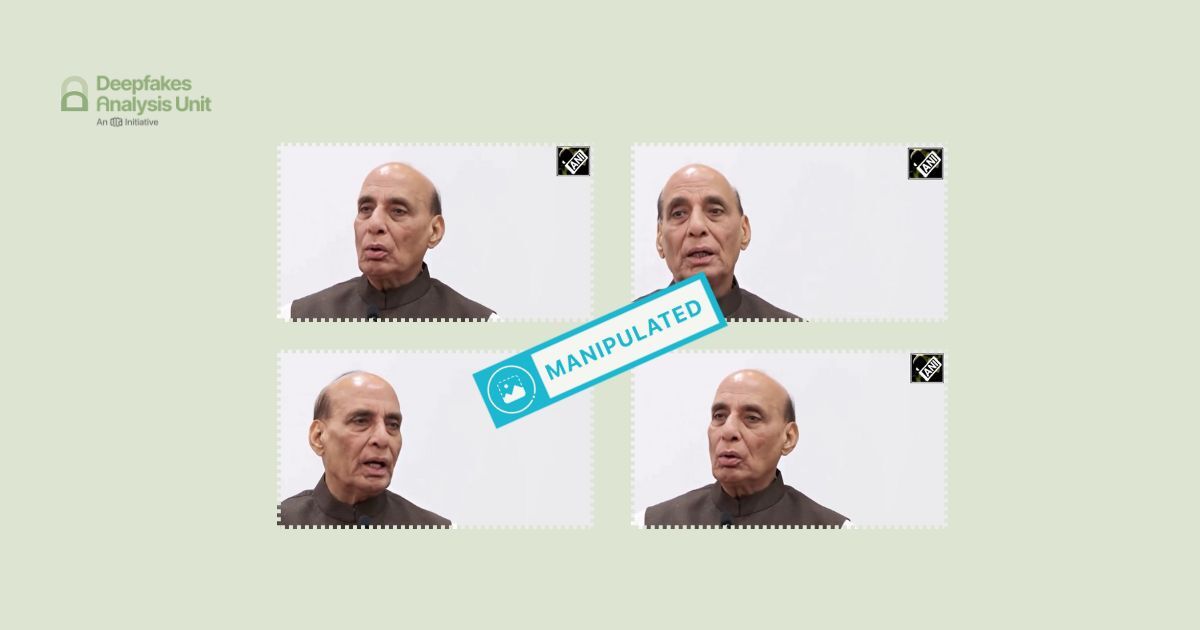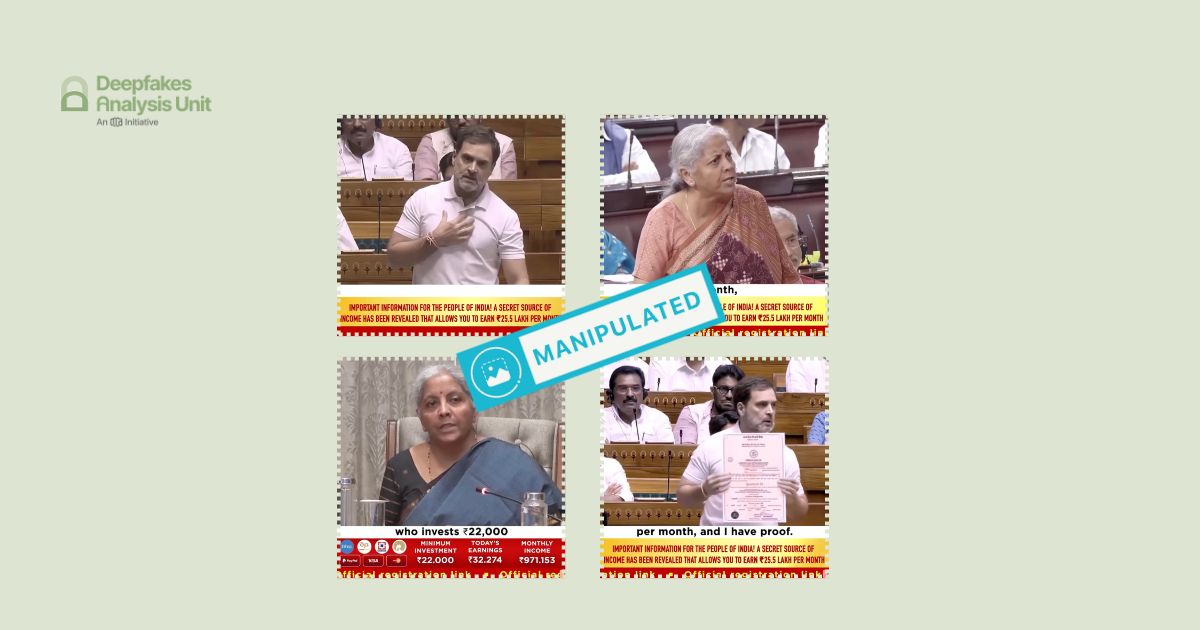The Deepfakes Analysis Unit (DAU) analysed a video that apparently shows Air Chief Marshal Amar Preet Singh, India’s Chief of Air Staff, supposedly making a statement about India having lost two S-400 batteries to Pakistan. After putting the video through A.I. detection tools and getting our expert partners to weigh in, we were able to conclude that an A.I.-generated audio clip was spliced with real audio to fabricate the video.
The 47-second video in English was discovered by the DAU on X, formerly Twitter, during social media monitoring. It was posted from several accounts on the platform though with different accompanying text. One such account, with the display name of “The Whistle Blower” posted the video on Sept. 20.
The text with the video, in English, read: “Indian Airforce Chief blames India(sic) Air defense officers for the loss of S-400 systems. He says that operators of the system couldn’t use the mobility of the weapons timely to evade Pakistan Airforce strikes on the air defense systems. He assures India that not to worry as they have ordered 2 more systems from Russia”.
We don’t have any evidence to suggest that the suspicious video originated from the aforementioned account or another. However, the same account had posted a slew of A.I. manipulated videos, we debunked most of those including one in which the air chief marshal apparently said that India had lost six jets and one Heron drone to Pakistan.
That account has been withheld by X, currently, which means that the content on the account timeline is not accessible to us in India from where we are writing this report.
The S-400 air defence missile systems were deployed by India during the military escalation with Pakistan in May 2025. According to news reports Russia will deliver additional S-400 systems to India by 2026 as part of a deal through which India already has three of those systems in use. An S-400 squadron comprises two batteries.
The air chief marshal is captured in a medium close-up in the video. He appears to be standing at a podium with two microphones, addressing an audience as his gaze shifts in different directions throughout the video. His backdrop is navy blue. A logo resembling that of The Economic Times, an Indian English-language business daily, can be seen in the top right corner of the video frame.
The overall video quality is decent. However, the synchronisation between the audio track and the air chief marshal’s lip movements is poor. His mouth appears to move in a puppet-like manner. His teeth seem to lose definition toward the end of the video, they look like patches of off-white.
At one point in the video, the air chief marshal’s facial expression changes abruptly, accompanied by an almost unnatural change in the outline of his beard. In yet another frame he seems to move his head in an unnaturally fast manner.
The insignia on the air chief marshal’s headgear changes shape throughout the video and reflects light in an unnatural manner. His nameplate appears blank in some frames while garbled characters are visible on it at other instances in the video. The oak leaves below the stars on the gorget or the decorative collar patches on his uniform seem distorted in various frames. His medal ribbons as well as the Indian Air Force(IAF) pilot’s badge worn above it look misrepresented in some frames.
All the visual oddities highlighted above point to signs of possible digital manipulation in the video.
On comparing the voice attributed to the air chief marshal in the video with his recorded speeches available online, the voice, diction, and accent match exactly with about the first 25 seconds of the audio track. However, the remaining 22 seconds of the audio track sound different; the voice sounds somewhat similar but the overall delivery is slower, sounds scripted, and the audio abruptly gets louder in that segment compared to the previous one.
We undertook a reverse image search using screenshots from the video and traced the air chief marshal’s clip to this post published on X on Sept. 19, 2025 from the official handle of The Economic Times. The backdrop of the air chief marshal in this video and the one we reviewed are identical. (A longer version of the video was published on the YouTube channel of ANI, an Indian news agency, on the same date.)
The details on his uniform, his body language are not the same in the source video and the video under review. However, there is a segment in the audio track of the source video, which is an exact match with the initial 25 seconds of the video under review.
The insignia on the air chief marshal’s headgear and gorget, medal ribbons, IAF pilot’s badge are not misrepresented in the source video; his nameplate also does not carry any garbled characters. A badge visible on his left breast pocket in the source video is not part of the doctored video.
The air chief marshal speaks in a mix of Hindi and English in the source video, which has no trace of the distinct 22-second audio heard in the latter part of the doctored video. The source video also has subtle background music and ambience sound; a very faint version of the same music can be heard in one segment of the doctored video but it has no ambience sound.
On comparing the video tracks of the segments that have an identical audio track in the manipulated as well as the source video, oddly, the air chief marshal’s body position and gestures are not identical. The positioning of the microphones in both the clips is also different. The editing in the doctored video looks fairly smooth without glaring jump cuts or transitions but for two glitches that we pointed to above, the visual mismatch could be a sign of manipulation.
The source video opens with a montage comprising a still image of the air chief marshal with a microphone in his left hand, the Indian Air Force flag next to his right arm, and an image of the S-400 system forming the backdrop. The words “with S-400, they couldn’t operate in their own airspace” written in bold are visible right above the montage.
The logo of The Economic Times can be seen in the lower right corner of that montage. As soon as the video plays the logo shifts to the upper right corner of the frame. The montage is not visible in the doctored video, though the same ET logo is visible in the doctored video.
The video being addressed through this report is similar to several videos that the DAU has debunked in the wake of the recent India-Pakistan military escalation. Most of these videos have been fabricated using video clips of top Indian military officials or ministers, their audio tracks stitched together with A.I.-generated audio.
Shared below is a table that compares the English translation of the audio track from the doctored video with a segment of the audio track from the original video featuring the air chief marshal. We want to give our readers a sense of how similar the audio tracks are and how that can be misleading. We, of course, do not intend to give any oxygen to the bad actors behind this content.
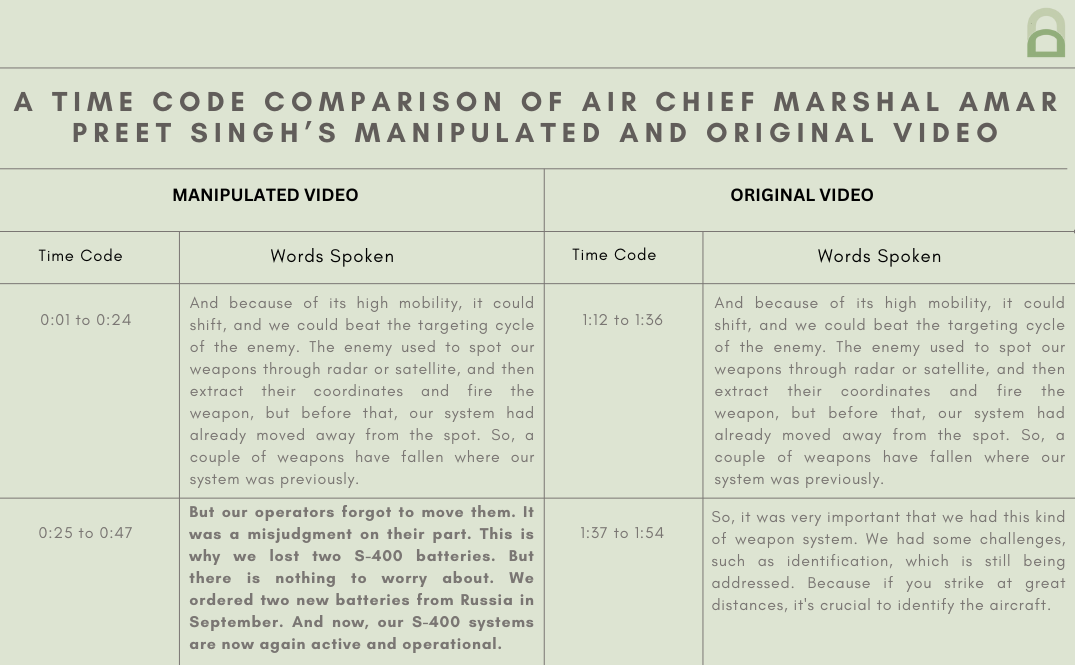
To discern the extent of A.I. manipulation in the video under review, we put it through A.I. detection tools.
The voice tool of Hiya, a company that specialises in artificial intelligence solutions for voice safety, indicated that there is an eight percent probability that the audio track in the video was generated or modified using A.I.
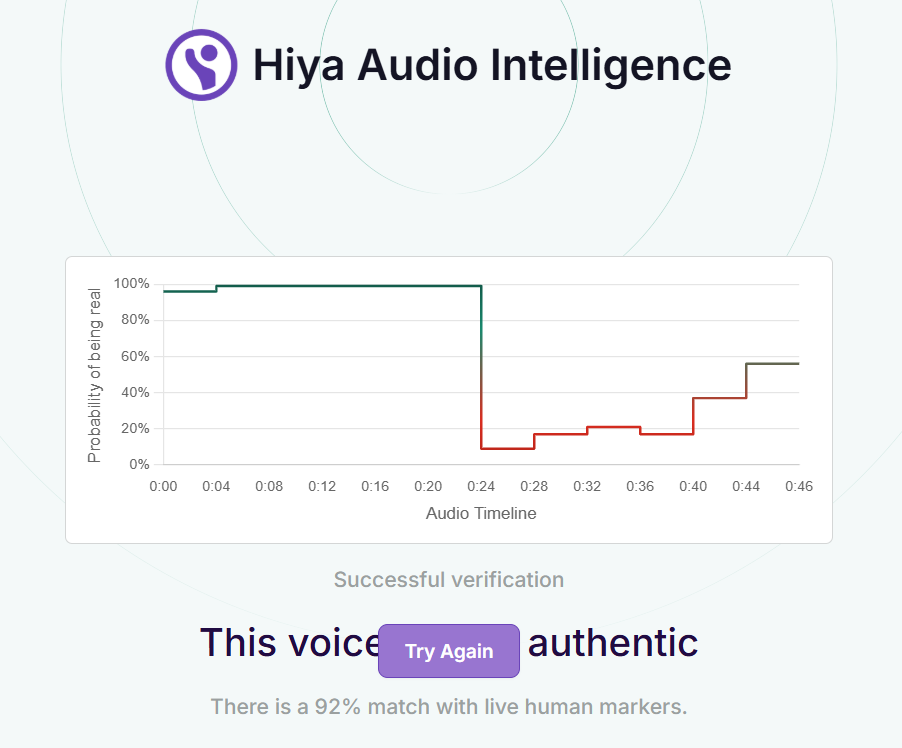
Hive AI’s deepfake video detection tool highlighted markers of A.I. manipulation in two segments of the video track. However, their audio detection tool indicated that the entire audio track is “not A.I.-generated”.
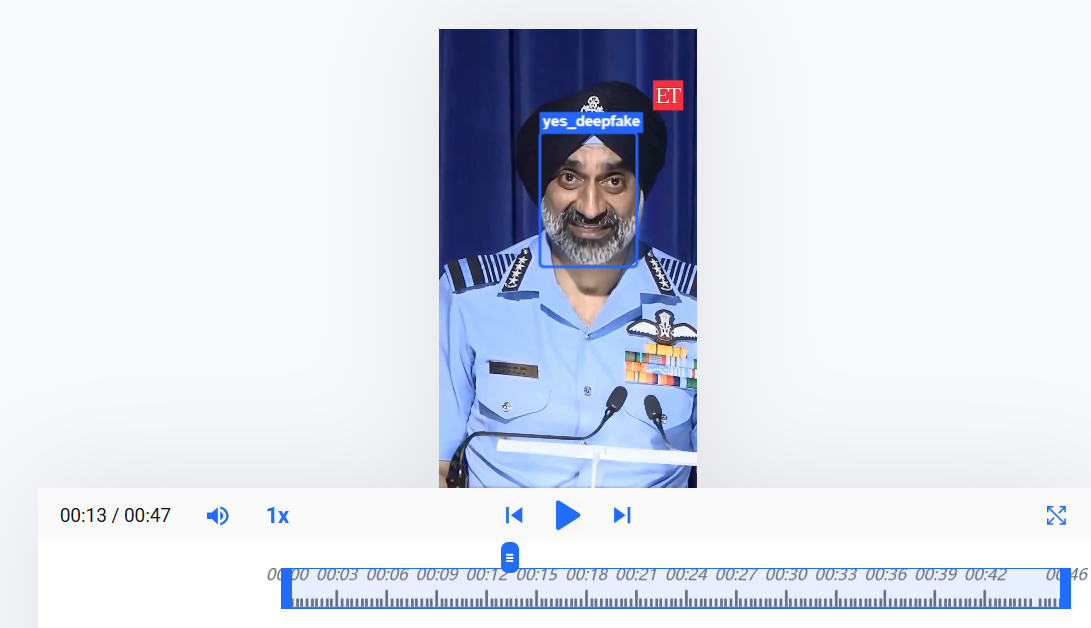
We ran the audio track through the advanced audio deepfake detection engine of Aurigin AI, a Swiss deep-tech company. The result that returned indicated that 40 percent of the audio track is A.I.-generated; the generated portion is limited to the second half of the audio track.

We also put the audio track through the A.I. speech classifier of ElevenLabs, a company specialising in voice A.I. research and deployment. The results indicated that it was “unlikely” that the audio track used in the video was generated using their platform.
When we reached out to ElevenLabs for a comment on the analysis, they told us that based on technical signals analysed by them they were able to confirm that the audio track in the video is synthetic or A.I.-generated. They added that they have taken action against the individuals who misused their tools to hold them accountable.
To get expert analysis on the video we reached out to our partners at RIT’s DeFake Project. Saniat Sohrawardi and Kelly Wu from the project noted that the video has notable artefacts, which indicate fakeness.
Ms. Wu pointed to specific timecodes in the doctored video and the source video that had identical audio and noted how in the source video the air chief marshal’s hand moves around his face, which is not the case in the doctored video. Wu added that, in the doctored video his mouth appears completely closed with a very stiff look, which indicates bad generation.
She further noted the presence of a silver-star-like thing on the air chief marshal’s right shirt pocket in the source video, which is missing from the doctored video. The ribbon bar above his right shirt pocket also changes across the doctored video, especially the light blue portion in the middle row where the pattern is a bit more complex.
Explaining the discrepancy in the microphones in two sets of videos that we too pointed to above, she added that, it appears that the microphones are carved and pasted into the doctored video and are static. In the source video the microphone on the left can be seen moving as the air chief marshal’s body moves.
Akib Shahriyar from the project confirmed our observations about the audio quality changing noticeably in the doctored video around the 24-second mark, especially the voice intonation and sharpness. Mr. Shahriyar suggested that it points to TTS or text-to-speech generation with the rhythm and intonation being slightly off. Shahriyar added that the transition from the original to the generated segment isn’t smooth.
He highlighted that the air force chief’s nameplate morphs between a single line, double lines with five pieces, and other variations. He pointed to the image-to-video model’s difficulty in maintaining text consistency across frames over time. He noted that the transition from original to the generated audio segment isn’t smooth.
He added to Wu’s observations about the microphones, suggesting that the base cropping still shows background artefacts from the original video, and the edges of the microphones are not clean.
On the basis of our observations and expert analyses, we can conclude that the video is fabricated. An A.I.-generated audio clip was inserted in the real audio track of the air chief marshal and used with his visuals to peddle a false narrative about India’s losses in the recent India-Pakistan conflict.
(Written by Debraj Sarkar and Debopriya Bhattacharya, edited by Pamposh Raina.)
Kindly Note: The manipulated audio/video files that we receive on our tipline are not embedded in our assessment reports because we do not intend to contribute to their virality.
You can read the fact-checks related to this piece published by our partners:
Video Claiming To Show IAF Chief Admitting Loss Of S-400s During Conflict With Pakistan Is Doctored




